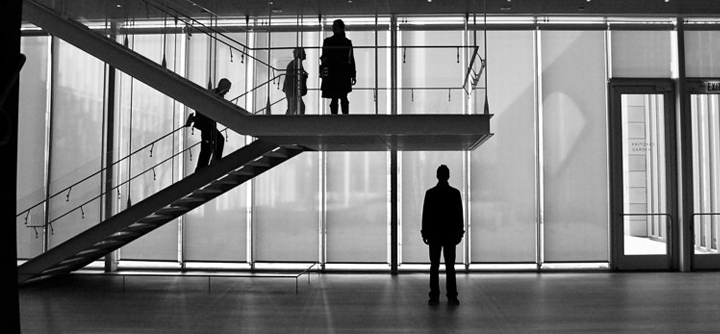
Patrons at the Art Institute’s Modern Wing. (Photography by Justin Brouillette, CC BY 2.0)
The Art Institute’s modern collection comes home.
Chicagoans love their modern masterpieces. So much that in April, when the Art Institute reinstalled 100 works of painting and sculpture after a seven-month absence, members came to the Modern Wing to welcome them back. Hundreds packed a weekday afternoon lecture by curator Stephanie D’Alessandro, AM’90, PhD’97, who gave reasons why the world-class collection deserves a fresh look.
Since the Modern Wing opened in 2009, millions of visitors have left their mark. The museum has repainted and refinished walls, floors, cases, and platforms in the third-floor galleries and improved the lighting system. During the renovation, works by Picasso, Matisse, Dalí, and others were loaned to the Kimbell Art Museum in Texas for the opening of its Renzo Piano Pavilion.
The Department of Conservation treated canvasses and reframed works including Max Pechstein’s The Red House and Lyonel Feininger’s Carnival in Arcueil. D’Alessandro and her team did archival research to discover how the artists might have framed the works in 1911: “We had frames made in Germany by master craftsmen to fit these pictures for the time that they were made.”
In a corner gallery, Marc Chagall’s White Crucifixion faces a 1937 self-portrait by Max Beckmann. Both artists experienced Nazi persecution and left Europe for America in the 1940s. The German artist Otto Dix stayed behind, but he began painting landscapes rather than social critiques to avoid arrest. His Shattered Tree, now on long-term loan to the Art Institute, shows how Dix “put himself into exile into his landscapes.”
The Art Institute has a world-renowned Surrealist collection. “There’s no way you could show it badly,” says D’Alessandro, but she always felt that the movement’s later decades deserved more attention. Looking at works in storage, she decided to bring out Kurt Seligmann’s Magnetic Mountain. The 1948 painting now hangs prominently in the refurbished galleries.
Visitors to the third floor will find new acquisitions, such as an untitled work by Romanian avant-garde artist M. H. Maxy and Object with Number One, a 1932 sculpture by Uruguayan Joaquin Torres-Garcia. The museum has also launched a free app with historical information, audio and video clips, and articles about the modern art collection.
In with the old, in with the new.
